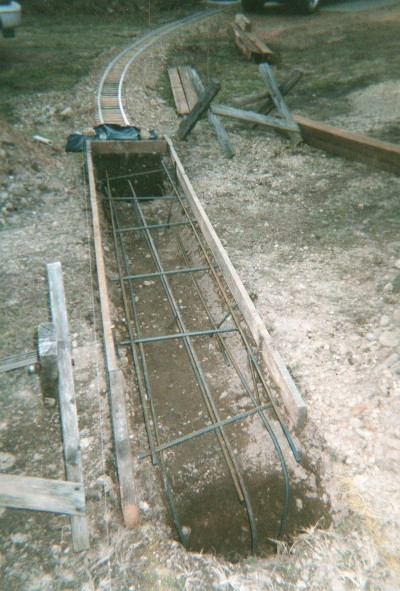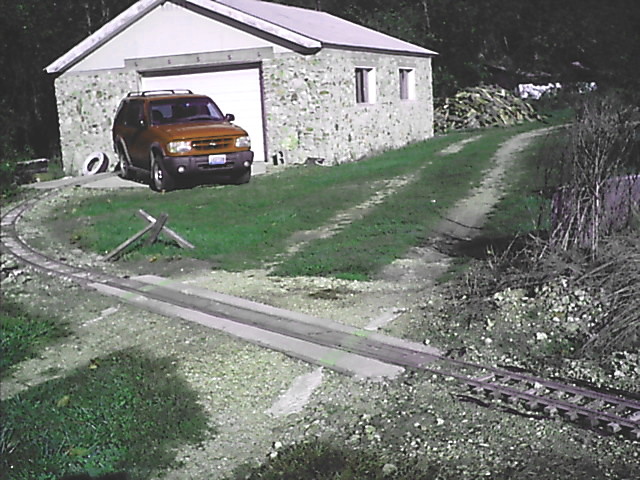A neighbor uses an access to his house which passes by my shop, across our property. The access road lies between my shop and track layout, so the track spur laid from the main layout to the shop must cross the access road. A crossing capable of heavy truck passage was needed as he expects to have ready-mix concrete trucks come up to his property.
My "scrounged" 2X8 and other timbers allowed the forming of a crossing 9 feet wide, and I figgered it would need to be at least 2 feet in width the other direction, since the track crossing it would be 7-1/2" gauge.
The pic below shows the trench we dug, with 2 fairly deep holes, one at either end. 1/2" reinforcing steel bar was layed such that it curved downward at the ends of the crossing, down into the 2 holes. The part between was also "laced" with rebar, as can be seen below. The pic was taken early, before the entire complement of iron was set in the trench; it wound up with about a 6X6 inch "mesh" of it. I further figgered, since the shallower area between the 2 holes did not extend deep enough to avoid "frost-heave", but the holes did, this would give some assurance against the thinner part cracking. Evidently, the idea was sound, as the finished crossing has witnessed about 4 winters now without degradation.

This shot shows the completed crossing, with the track laid through it, a 2X6 "shot" to the concrete between the rails, to carry vehicular weight without exposing the rail itself to but very little loading. The top of the "slab" while still wet concrete had a slightly-narrowed 2X10 (1-1/2" thick) pressed down into it until flush with the top surface. This formed the channel which, after set-up and removal of the 2X10, left a "groove" in which to mount the rails. Suppose we'll need to meet some regulatory criterion and place signals and cross-arms here?
Not very sophisticated, I admit, but it has held up so far. Thanks fer lookin'! jack

My "scrounged" 2X8 and other timbers allowed the forming of a crossing 9 feet wide, and I figgered it would need to be at least 2 feet in width the other direction, since the track crossing it would be 7-1/2" gauge.
The pic below shows the trench we dug, with 2 fairly deep holes, one at either end. 1/2" reinforcing steel bar was layed such that it curved downward at the ends of the crossing, down into the 2 holes. The part between was also "laced" with rebar, as can be seen below. The pic was taken early, before the entire complement of iron was set in the trench; it wound up with about a 6X6 inch "mesh" of it. I further figgered, since the shallower area between the 2 holes did not extend deep enough to avoid "frost-heave", but the holes did, this would give some assurance against the thinner part cracking. Evidently, the idea was sound, as the finished crossing has witnessed about 4 winters now without degradation.

This shot shows the completed crossing, with the track laid through it, a 2X6 "shot" to the concrete between the rails, to carry vehicular weight without exposing the rail itself to but very little loading. The top of the "slab" while still wet concrete had a slightly-narrowed 2X10 (1-1/2" thick) pressed down into it until flush with the top surface. This formed the channel which, after set-up and removal of the 2X10, left a "groove" in which to mount the rails. Suppose we'll need to meet some regulatory criterion and place signals and cross-arms here?
Not very sophisticated, I admit, but it has held up so far. Thanks fer lookin'! jack






